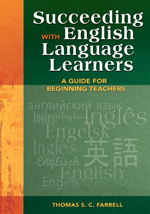Preface
Acknowledgments
About the Author
Ch 1: Teaching in the First Year
Exploratory Break 1.1: Teaching in the First Year
Exploratory Break 1.2: First Year Phases of Development
Exploratory Break 1.3: Stages of Development
Exploratory Break 1.4: Stacy's First Years of Development
Exploratory Break 1.5: Stacy's First Years of Support
Exploratory Break 1.6: Mentors
Exploratory Break 1.7: Teaching Load
Exploratory Break 1.8: Nature of Classes during the First Years
Exploratory Break 1.9: Helping Yourself
Chapter Reflection
Ch 2: Planning English Language Lessons
Exploratory Break 2.1: Why Plan Lessons?
Exploratory Break 2.2: Benefits of Planning Lessons
Exploratory Break 2.3: Lesson Plan Details
Exploratory Break 2.4: Writing Lesson Objectives
Exploratory Break 2.5: Lesson Design
Exploratory Break 2.6: Questions to Consider Before Lessons
Exploratory Break 2.7: Components of a Language Lesson
Exploratory Break 2.8: Questions for Teachers to Consider After the Lesson
Exploratory Break 2.9: Questions for Students to Consider After the Lesson
Chapter Reflection
Ch 3: Classroom Management
Exploratory Break 3.1: Teacher: Manager or Conductor
Exploratory Break 3.2: Organizing the Class
Exploratory Break 3.3: Conducting Group Work
Exploratory Break 3.4: Dealing with the Disengaged ESL Student
Exploratory Break 3.5: Facilitating Classroom Communication
Exploratory Break 3.6: Investigating Patterns of Interaction in Your Classroom
Exploratory Break 3.7: Facilitating Diversity
Exploratory Break 3.8: Facilitating Different Learning Styles
Exploratory Break 3.9: Looking Ahead
Chapter Reflection
Ch 4: Teaching Grammar
Exploratory Break 4.1: Teaching and Grammar
Exploratory Break 4.2: Grammar
Exploratory Break 4.3: Teaching Grammar
Exploratory Break 4.4: Inductive and Deductive Grammar Teaching
Exploratory Break 4.5: Why Is English So Hard?
Exploratory Break 4.6: Grammar Activity Using the CRISP Method
Exploratory Break 4.7: Create your own Grammar Activities Using the CRISP Method
Chapter Reflection
Ch 5: Teaching Writing
Exploratory Break 5.1: Writing
Exploratory Break 5.2: Purpose and Audience
Exploratory Break 5.3: Writing as Product
Exploratory Break 5.4: Writing as Process
Exploratory Break 5.5: Teaching Writing
Exploratory Break 5.6: Assumptions About Writing
Exploratory Break 5.7: Peer Evaluation
Exploratory Break 5.8: Peer Editing
Exploratory Break 5.9: Feedback
Exploratory Break 5.10: The Place of Grammar
Chapter Reflection
Ch 6: Teaching Speaking
Exploratory Break 6.1: Speaking a Second/Foreign Language
Exploratory Break 6.2: Rules of Face-to-Face Interaction
Exploratory Break 6.3: Turn-taking
Exploratory Break 6.4: Teaching Turn-taking
Exploratory Break 6.5: Establishing Topics
Exploratory Break 6.6: Topics
Exploratory Break 6.7: Conversation Breakdowns
Exploratory Break 6.8: Repair
Exploratory Break 6.9: Teaching Dimensions of Speaking
Exploratory Break 6.10: Accuracy versus Fluency
Exploratory Break 6.11: Guidelines for Planning Speaking Lessons
Exploratory Break 6.12: Project Focus
Exploratory Break 6.13: Project Information
Exploratory Break 6.14: Class Project
Chapter Reflection
Ch 7: Teaching Reading
Exploratory Break 7.1: Reading Habits
Exploratory Break 7.2: Reading Definition
Exploratory Break 7.3: Models of Reading
Exploratory Break 7.4: Reading Strategy Profile
Exploratory Break 7.5: Reading Strategies
Exploratory Break 7.6: Prior Knowledge
Exploratory Break 7.7: Word Association
Exploratory Break 7.8: Direct Experience
Exploratory Break 7.9: Cinquain
Exploratory Break 7.10: Prediction
Exploratory Break 7.11: Skimming
Exploratory Break 7.12: Scanning
Exploratory Break 7.13: Teaching New Vocabulary
Exploratory Break 7.14: Text Structures
Chapter Reflection
Ch 8: Teaching Listening
Exploratory Break 8.1: Listening
Exploratory Break 8.2: Bottom-up Processing
Exploratory Break 8.3: Top-Down Processing
Exploratory Break 8.4: Interactional Purposes
Exploratory Break 8.5: Transactional Purposes
Exploratory Break 8.6: Back-channelling Signals
Exploratory Break 8.7: Local, Global, and Transitional Repairs
Exploratory Break 8.8: Comprehension Checks
Exploratory Break 8.9: Soap Activities
Chapter Reflection
Ch 9: Language Assessment
Exploratory Break 9.1: Language Assessment
Exploratory Break 9.2: Reliability and Validity
Exploratory Break 9.3: Alternative Assessment
Exploratory Break 9.4: Criterion and Norm Reference Assessment
Exploratory Break 9.5: Selected-response Assessment
Exploratory Break 9.6: Multiple-choice Tests
Exploratory Break 9.7: True-false Tests
Exploratory Break 9.8: Matching Tests
Exploratory Break 9.9: Short-answer Tests
Exploratory Break 9.10: Essay Tests
Exploratory Break 9.11: Fill-in Tests
Exploratory Break 9.12: Oral Tests
Exploratory Break 9.13: Portfolios
Exploratory Break 9.14: Self/Peer Assessment
Exploratory Break 9.15: Constructing Language Tests
Exploratory Break 9.16: Create Your Own Language Test
Chapter Reflection
Ch 10: Professional Development
Exploratory Break 10.1: Professional Development Needs Assessment
Exploratory Break 10.2: Opportunities for Reflection and Development
Exploratory Break 10.3: Action Research
Exploratory Break 10.4: Critical Incidents
Exploratory Break 10.5: Teaching Journal
Exploratory Break 10.6: Classroom Observations
Exploratory Break 10.7: Teacher Group Discussion
Chapter Reflection
References
Index



